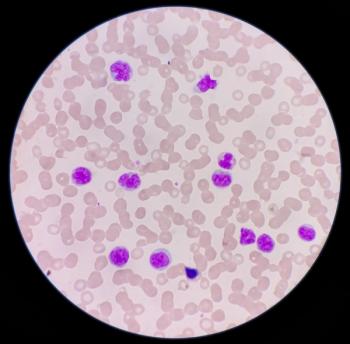
Myelofibrosis
Latest News
Latest Videos
CME Content
More News

Experts discuss obstacles faced while transitioning myelofibrosis patients from inpatient to outpatient care, emphasizing communication, access to medication, and the need for standardized medication reconciliation protocols.

Pharmacists discuss challenges in transitioning myelofibrosis patients between inpatient and outpatient care settings, emphasizing medication reconciliation and seamless inter-team communication.

Pharmacists analyze the role of momelotinib in treating anemia in myelofibrosis, exploring its place in practice and impact on patient care amid emerging therapies.

Pharmacists discuss the impact and alternatives amid red blood cell shortages in myelofibrosis treatment, highlighting challenges, patient outcomes, quality of life issues, and health care cost implications.

Experts discuss the ramifications of red blood cell transfusion shortages on myelofibrosis patient management and delve into the scarcity’s effects, patient prioritization, and the struggle for consistency in care amid supply challenges.

Zahra Mahmoudjafari, PharmD, MBA, BCOP, FHOPA, and a panel of pharmacists explore pharmacist roles in myelofibrosis care, treatment challenges, patient outcomes, and pharmacist responsibilities within interdisciplinary teams.

The model may help clinicians identify patients who would benefit from disease-specific therapies or enrollment into clinical trials.

Expert explains how the role of pharmacists in myelofibrosis treatment has evolved significantly over the past decade.

Ruben A. Mesa, MD, FACP, discusses the results of the SIMPLIFY-1 and MOMENTUM trials and how the data led to the approval of momelotinib to treat intermediate or high-risk myelofibrosis in adult patients with anemia.

Most patients with myelofibrosis will develop anemia over the course of the disease, with more than 30% discontinuing treatment as a result.

Pharmacists also have the resources to help advocate for better care for patients.

Despite a slew of barriers with patient management, pharmacists have the training and resources to advocate for better patient care and help patients with hematologic myeloproliferative neoplasms advocate for themselves.

The regulatory submission includes data from the MOMENTUM phase 3 clinical trial that met all primary and key second efficacy end points.

Thrombocytopenia was the most common adverse effect, which was managed through dose reduction.

Ahmed Kotb, MD, vice president of US medical affairs, oncology, at AbbVie, discussed new findings from the REFINE trial and what they could mean for patients with myelofibrosis.

Results are from an exploratory analysis of 34 patients who received at least 1 dose after disease progression or suboptimal response with ruxolitinib monotherapy

Pacritinib becomes the first treatment approved to specifically address the needs of patients with cytopenic myelofibrosis.

Rami Komrokji, MD, clinical director of malignant hematology and department lead clinical investigator at the H. Lee Moffitt Cancer Center and Research Institute speaks about why data are limited in myelofibrosis.

Pacritinib is a JAK2/FLT3 inhibitor for the treatment of patients with myelofibrosis and severe thrombocytopenia defined as platelet counts of less than 50,000 μL.

This cancer is characterized by scar tissue accumulation in the bone marrow, which leads to an insufficient quantity of normal blood cells.

Top news of the day from across the health care landscape.

Officials from the FDA have granted Geron Corporation’s imetelstat fast track designation for adult patients with intermediate-2 or high-risk myelofibrosis (MF) whose disease has relapsed after or is refractory to janus kinase (JAK) inhibitor treatment.

If approved, fedratinib would be the second FDA-approved treatment for myelofibrosis.


















































































































































































































